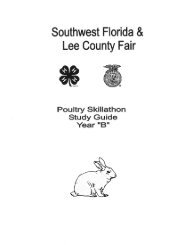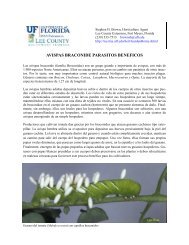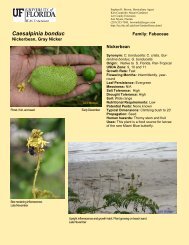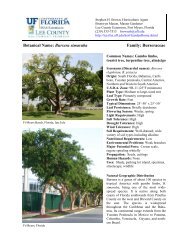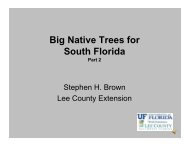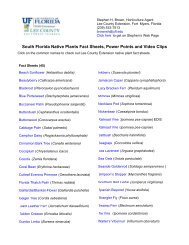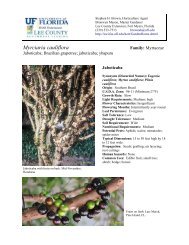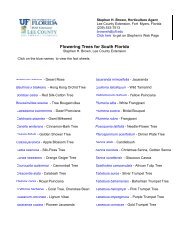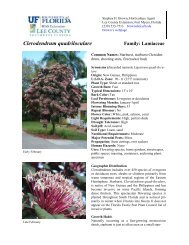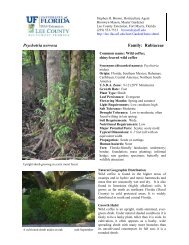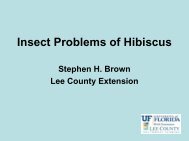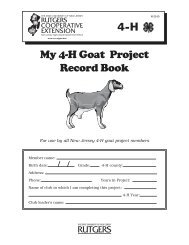79728115 R.0 f Fruit, Citrus & Vegetable Insect Control 32oz CON
79728115 R.0 f Fruit, Citrus & Vegetable Insect Control 32oz CON
79728115 R.0 f Fruit, Citrus & Vegetable Insect Control 32oz CON
You also want an ePaper? Increase the reach of your titles
YUMPU automatically turns print PDFs into web optimized ePapers that Google loves.
<strong>Fruit</strong>, <strong>Citrus</strong><br />
& <strong>Vegetable</strong><br />
<strong>Insect</strong> <strong>Control</strong><br />
<strong>CON</strong>CENTRATE<br />
SEASON-LONG<br />
PROTECTION<br />
Kills <strong>Insect</strong>s &<br />
Prevents New<br />
Infestations<br />
PROTECCIÓN TODA LA TEMPORADA<br />
Mata los insectos y previene nuevas<br />
infestaciones<br />
Specially formulated<br />
for fruits & vegetables<br />
See back panel booklet for additional<br />
CAUTION precautionary statements<br />
KEEP OUT OF REACH OF CHILDREN<br />
Active Ingredients:<br />
Imidacloprid ............ 0.235%<br />
Other Ingredients ... 99.765%<br />
Total 100.000%<br />
Not for sale, sale into, distribution, and or use in Nassau, Suffolk,<br />
Kings, and Queens counties of New York<br />
MIX & POUR AT<br />
PLANT BASE<br />
Rainproof<br />
NET <strong>CON</strong>TENTS 32 FL OZ (946ml)<br />
<strong>79728115</strong> <strong>R.0</strong>
FIRST AID ✚<br />
IF<br />
SWALLOWED<br />
IF IN EYES<br />
Frui <strong>Fruit</strong>, ruit, <strong>Citrus</strong><br />
& <strong>Vegetable</strong><br />
<strong>Insect</strong> <strong>Control</strong><br />
<strong>CON</strong>CENTRATE<br />
This product provides systemic insect<br />
protection with a single application on listed<br />
fruit and nut trees, citrus, and vegetables.<br />
Keeping your plants protected from listed<br />
damaging insects has never been easier.<br />
PRECAUTIONARY STATEMENTS<br />
CAUTION Hazards to Humans and Domestic Animals<br />
• Causes moderate eye irritation.<br />
• Avoid contact with skin, eyes, or clothing.<br />
• Wash thoroughly with soap and water after handling and before eating,<br />
drinking, chewing gum or using tobacco.<br />
• Call a poison control center or doctor immediately for<br />
treatment advice.<br />
• Have person sip a glass of water if able to swallow.<br />
• Do not induce vomiting unless told to do so by a poison<br />
control center or doctor.<br />
• Do not give anything by mouth to an unconscious person.<br />
• Hold eye open and rinse slowly and gently with water for<br />
15 to 20 minutes.<br />
• Remove contact lenses, if present, after the first 5 minutes,<br />
then continue rinsing eye.<br />
• Call a poison control center or doctor for treatment advice.<br />
NOTE: When calling poison control center, have this product label accessible.<br />
If seeking treatment at an emergency room or doctor’s office, bring this<br />
product label to show medical personnel.<br />
You may call toll-free 1-877-229-3763 for medical emergency information.<br />
Active ingredient: 0.235% Imidacloprid [CAS # 138261-41-3].<br />
NOTICE: Research and testing have determined that the “Directions for Use” are<br />
appropriate for the proper use of this product under expected conditions. The<br />
Buyer assumes responsibility for lack of performance or safety if not used<br />
according to the directions.<br />
Money Back Guarantee: If you are not satisfied with this product, we will gladly<br />
refund your original purchase price.<br />
Produced for:<br />
Bayer Advanced<br />
A Business Unit of Bayer CropScience LP<br />
P.O. Box 12014, 2 T.W. Alexander Drive<br />
Research Triangle Park, NC 27709<br />
Bayer (reg’d), Bayer Cross (reg’d), Bayer Advanced<br />
are trademarks of Bayer.<br />
EPA Reg. No. 72155-92<br />
EPA Est. No indicated by 3rd and<br />
4th digits of the batch number on<br />
this package.<br />
(65) = 432-TX-1 (68) = 67572-GA-1<br />
(39) = 58996-MO-1<br />
(49) = 072155-AL-001<br />
PRESS TO RESEAL<br />
79728689 <strong>R.0</strong>
NOTA: Investigaciones y pruebas han determinado que las “Indicaciones de uso” son las adecuadas para el uso<br />
apropiado de este producto bajo las condiciones previstas. El Comprador asume la responsabilidad por la falta de<br />
rendimiento o seguridad si no es utilizado de acuerdo con las indicaciones.<br />
Garantía de devolución de dinero: Si usted no está satisfecho con el producto, gustosamente le reembolsaremos el<br />
monto original del precio de compra.<br />
JUST MIX ...<br />
AND POUR<br />
AT PLANT BASE.<br />
FOR OUTDOOR<br />
RESIDENTIAL<br />
USE ONLY<br />
Not for use on crops being<br />
grown for sale or other<br />
commercial use<br />
ACTIVE INGREDIENT:<br />
Imidacloprid . . . . . . . . . 0.235%<br />
OTHER<br />
INGREDIENTS . . . . . . 99.765%<br />
Total 100.00%<br />
EPA Reg. No. 72155-92<br />
EPA Est. No indicated by 3rd<br />
and 4th digits of the batch<br />
number on this package.<br />
(65) = 432-TX-1 (68) = 67572-GA-1<br />
(39) = 58996-MO-1 (49) = 072155-AL-001<br />
READ THE LABEL FIRST!<br />
QUICK FACTS<br />
• Easy to Use . . .<br />
Mix in Water and<br />
Pour Around Plant Base<br />
• Rainproof<br />
• Convenient Measure-Up Cup<br />
KILLS<br />
COVERAGE<br />
WHERE<br />
TO USE<br />
WHEN<br />
TO USE<br />
WHEN<br />
TO<br />
HARVEST<br />
HOW<br />
MUCH<br />
TO USE<br />
79728689 <strong>R.0</strong><br />
OPEN<br />
Resealable Label<br />
for Directions &<br />
Precautions<br />
Indicaciones<br />
en español<br />
después de las<br />
de inglés<br />
Aphids, beetles, leafhoppers, scale,<br />
thrips, whiteflies, and other listed<br />
pests.<br />
Treats 640 square feet of vegetables<br />
Treats up to 9 fruit trees with a<br />
canopy width of 10 feet.<br />
<strong>Fruit</strong> & Nut trees including citrus,<br />
apple, peach, cherry, plum and<br />
other listed.<br />
<strong>Vegetable</strong>s including tomato,<br />
pepper, carrot, melon, cucumber,<br />
herbs, and other listed.<br />
Strawberry, blueberry, raspberry,<br />
grape and other listed.<br />
Apply once a year at labeled<br />
application timing. See below for<br />
plant specific directions.<br />
See Plant Specific restrictions for<br />
Pre Harvest Interval.<br />
If no Pre Harvest Interval is listed,<br />
then product may be applied up to<br />
and including day of harvest.<br />
<strong>Vegetable</strong>s, strawberry, bushberry,<br />
caneberry, and grape -<br />
0.5 oz. per 10 square feet.<br />
<strong>Fruit</strong> & Nut trees:<br />
See Tree rate chart.<br />
For questions or comments,<br />
call toll-free 1-877-BayerAG<br />
(1-877-229-3724)
DIRECTIONS FOR USE<br />
It is a violation of Federal Law to use this product in a manner inconsistent<br />
with its labeling.<br />
Read and follow all label directions.<br />
BEFORE<br />
YOU USE<br />
Read and follow<br />
directions<br />
when using.<br />
HOW THIS<br />
PRODUCT<br />
WORKS<br />
APPLICATION<br />
TIMING<br />
HOW<br />
TO USE<br />
• Do not apply near lakes, streams, rivers, or ponds.<br />
• Do not apply to soils which are water-logged or saturated.<br />
• Bucket or measuring utensils must not be used for any food or<br />
drinking water purposes after use with this product.<br />
• During prolonged dry periods, saturate the soil around the plants<br />
well with water the night before making an application.<br />
The insecticide dissolved in water moves down through the soil, where<br />
it is absorbed by the roots. Once absorbed, it moves up through the<br />
plant providing insect protection. This product even moves into new<br />
growth after application, thus protecting it, too! For insect control, the<br />
insecticide must distribute completely through the plant. Depending<br />
on the size and health of the plant, this may take one week to three<br />
months (for very large trees). Rain or water cannot wash off this<br />
internal protection.<br />
FRUIT AND NUT TREES<br />
(See tables for Trees and Pests controlled)<br />
Radius Feet<br />
Distance in feet from<br />
trunk to drip line<br />
3<br />
4<br />
5<br />
6<br />
7<br />
8<br />
9<br />
10<br />
Use at first signs of insect infestation, preferably before damage from<br />
feeding occurs.<br />
1. Measure the distance from the tree trunk to the drip line, and round<br />
down to the nearest foot.<br />
Note: The drip line is the outer edge of the leaves. If you visualize an<br />
umbrella in the rain; the area where the rain falls to the ground<br />
would be the drip line.<br />
2. Consult the tree rate chart to determine the number of ounces of<br />
product to use for your specific tree type and radius measurement.<br />
3. Add the specified amount of product to 1 gallon of water.<br />
4. Pour the mixture at the base of the tree.<br />
5. Fill the bucket with an additional gallon of water and pour at the<br />
base of the tree.<br />
TREE RATE CHART<br />
Stone <strong>Fruit</strong> and Pome <strong>Fruit</strong><br />
including: Cherry, Peach,<br />
Apple and Pear<br />
Ounces of product to use<br />
1.0<br />
2.5<br />
3.5<br />
5.5<br />
7.5<br />
10.0<br />
12.5<br />
15.5<br />
Banana and Plantain, <strong>Citrus</strong>,<br />
Pomegranate, Tree Nut,<br />
and Tropical <strong>Fruit</strong><br />
including: Lemon, Lime, Orange,<br />
Mango and Avocado<br />
Ounces of product to use<br />
1.5<br />
3.0<br />
5.0<br />
7.5<br />
10.0<br />
13.5<br />
17.0<br />
21.0<br />
(cont’d)<br />
FRUIT AND NUT TREES (cont’d)<br />
TREE RATE CHART (cont’d)<br />
Radius Feet<br />
Distance in feet from<br />
trunk to drip line<br />
11<br />
12<br />
13<br />
14<br />
Stone <strong>Fruit</strong> and Pome <strong>Fruit</strong><br />
including: Cherry, Peach,<br />
Apple and Pear<br />
Ounces of product to use<br />
19.0<br />
22.5<br />
26.5<br />
30.5<br />
Banana and Plantain, <strong>Citrus</strong>,<br />
Pomegranate, Tree Nut,<br />
and Tropical <strong>Fruit</strong><br />
including: Lemon, Lime, Orange,<br />
Mango and Avocado<br />
Ounces of product to use<br />
25.0<br />
30.0<br />
--<br />
--<br />
BANANA and PLANTAIN<br />
PESTS <strong>CON</strong>TROLLED<br />
Aphids, Leafhoppers<br />
Restrictions<br />
Do not make more than one application per year.<br />
CITRUS<br />
Calamondin, <strong>Citrus</strong> citron, <strong>Citrus</strong> hybrids (includes chironja, tangelo, and tangor), Grapefruit,<br />
Kumquat, Lemon, Lime, Mandarin (tangerine), Pummelo, Orange (sweet and sour), Satsuma<br />
mandarin<br />
PESTS <strong>CON</strong>TROLLED<br />
Aphids, Asian citrus psyllid, Blackfly, <strong>Citrus</strong> leafminer, Leafhoppers/Sharpshooters, Mealybugs,<br />
Scales, Whiteflies<br />
Restrictions<br />
Do not make more than one application per year.<br />
POME FRUIT<br />
Apple, Crabapple, Loquat, Mayhaw, Pear (including Oriental pear), Quince<br />
PESTS <strong>CON</strong>TROLLED<br />
Aphids (including woolly apple aphid), Leafhoppers<br />
Restrictions<br />
Pre-harvest Interval: Do not harvest fruit until at least 21 days after application.<br />
Do not make more than one application per year.<br />
Do not apply until after trees have flowered or when bees are actively foraging.<br />
POMEGRANATE<br />
PESTS <strong>CON</strong>TROLLED<br />
Aphids, Leafhoppers/Sharpshooters, Whiteflies<br />
Restrictions<br />
Do not make more than one application per year.<br />
Do not apply until after trees have flowered or when bees are actively foraging.<br />
(cont’d)
STONE FRUIT<br />
Apricot, Cherry (including sweet and tart), Nectarine, Peach, Plum (including Chickasaw,<br />
Damson and Japanese), Plumcot, Prune<br />
PESTS <strong>CON</strong>TROLLED<br />
Aphids (including woolly apple aphid), Leafhoppers<br />
Restrictions<br />
Pre-harvest Interval: Do not harvest fruit until at least 21 days after application.<br />
Do not make more than one application per year.<br />
Do not apply until after trees have flowered or when bees are actively foraging.<br />
TREE NUTS<br />
Beechnut, Brazil nut, Butternut, Cashew, Chestnut, Chinquapin, Filbert, Hickory nut,<br />
Macadamia nut, Pecan, Pistachio, Walnut [black and English]<br />
PESTS <strong>CON</strong>TROLLED<br />
Aphids, Leafhoppers/Sharpshooters, Mealybugs, Spittlebugs, Whiteflies<br />
Restrictions<br />
Pre-harvest Interval: Do not harvest fruit until at least 7 days after application.<br />
Do not make more than one application per year.<br />
Do not apply until after trees have flowered or when bees are actively foraging.<br />
TROPICAL FRUIT<br />
Acerola, Atemoya, Avocado, Birida, Black sapote, Canistel, Cherimoya, Custard apple, Feijoa,<br />
Jaboticaba, Guava, Llama, Longan, Lychee, Mamey sapote, Mango, Papaya, Passionfruit,<br />
Persimmon, Pulasan, Rambutan, Sapodilla, Soursop, Spanish lime, Star apple, Starfruit,<br />
Sugar apple, Wax jambu<br />
PESTS <strong>CON</strong>TROLLED<br />
Aphids, Avocado lacebug, Leafhoppers, Whiteflies<br />
Restrictions<br />
Pre-harvest Interval: Do not harvest fruit until at least 6 days after application.<br />
Do not make more than one application per year.<br />
Do not apply until after trees have flowered or when bees are actively foraging.<br />
VEGETABLES<br />
(See tables for <strong>Vegetable</strong>s and Pests controlled)<br />
APPLICATION<br />
TIMING<br />
HOW<br />
TO USE<br />
To prevent insect infestation apply at transplant or shortly<br />
after plants emerge from seed.<br />
1. Measure the area of the vegetable row to be treated.<br />
Note: a row that is 1 ft. X 10 ft. is 10 square feet.<br />
2. Add 0.5 ounce of product per 10 square feet of vegetable row to be<br />
treated to 1 quart of water.<br />
3. Spread the mixture evenly over the vegetable row to be treated.<br />
(cont’d)<br />
CUCURBIT VEGETABLES<br />
Chayote (fruit), Chinese waxgourd (Chinese preserving melon), Citron melon, Cuban<br />
pumpkin, Cucumber, Gherkin, Gourd (edible, includes hyotan, cucuzza, hechima, Chinese<br />
okra), Momordica spp. (includes balsam apple, balsam pear, bitter melon, Chinese cucumber),<br />
Muskmelon (hybrids and/or cultivars of Cucumis melo including true cantaloupe, cantaloupe,<br />
casaba, Crenshaw melon, golden pershaw melon, honeydew melon, honey balls, mango<br />
melon, Persian melon, pineapple melon, Santa Claus melon, snake melon and Winter melon),<br />
Pumpkin, Squash (includes summer squash types such as: butternut squash, calabaza,<br />
crookneck squash, Hubbard squash, scallop squash, straightneck squash, vegetable marrow<br />
and zucchini, and winter squash types such as acorn squash and spaghetti squash),<br />
Watermelon (includes hybrids and/or varieties of Citrullus lanatus)<br />
PESTS <strong>CON</strong>TROLLED<br />
Aphids, Cucumber beetles, Leafhoppers, Thrips (foliage feeding thrips only), Whiteflies<br />
Restrictions<br />
Pre-harvest Interval: Do not harvest fruit until at least 21 days after application.<br />
Do not make more than one application per year.<br />
FRUITING VEGETABLES<br />
Eggplant, Ground cherry, Okra, Pepper (including bell, chili, cooking, pimento and sweet)<br />
Tomato, Pepinos, Tomatillo<br />
PESTS <strong>CON</strong>TROLLED<br />
Aphids, Colorado potato beetle, Flea beetles, Leafhoppers, Thrips (foliage feeding thrips,<br />
only), Whiteflies<br />
Restrictions<br />
Pre-harvest Interval: Do not harvest fruit until at least 21 days after application.<br />
Do not make more than one application per year.<br />
HERBS<br />
Angelica, Balm (lemon balm), Basil (fresh and dried), Borage, Bumet, Camomile, Catnip,<br />
Chervil (dried), Chinese chive, Chive, Clary, Coriander (cilantro or Chinese parsley leaves),<br />
Costmary, Culantro (leaf), Curry (leaf), Dillweed, Horehound, Hyssop, Lavender, Lemongrass,<br />
Lovage (leaf), Marigold, Marjoram, Nasturtium, Parsley (dried), Pennyroyal, Rosemary, Rue,<br />
Sage, Savory (summer and winter), Sweet bay (bay leaf), Tansy, Tarragon, Thyme,<br />
Wintergreen, Woodruff, Wormwood.<br />
PESTS <strong>CON</strong>TROLLED<br />
Aphids, Flea beetles, Leafhoppers, Whiteflies<br />
Restrictions<br />
Pre-harvest Interval: Do not harvest fruit until at least 14 days after application.<br />
Do not make more than one application per year.<br />
BRASSICA (COLE) LEAFY VEGETABLES<br />
Broccoli, Broccoli raab (rapini), Brussels sprouts, Cabbage, Cauliflower, Cavalo broccoli,<br />
Chinese (gai lon) broccoli, Chinese (bok choy) cabbage, Chinese (napa) cabbage, Chinese<br />
mustard (gai choy) cabbage, Collards, Kale, Kohlrabi, Mizuna, Mustard greens, Mustard<br />
spinach, Rape greens<br />
PESTS <strong>CON</strong>TROLLED<br />
Aphids, Leafhoppers, Thrips (foliage feeding thrips only), Whiteflies<br />
Restrictions<br />
Pre-harvest Interval: Do not harvest fruit until at least 21 days after application.<br />
Do not make more than one application per year.<br />
(cont’d)
LEAFY VEGETABLES<br />
Amaranth (leafy amaranth, Chinese spinach, tampala), Arugula (Roquette), Chervil,<br />
Chrysanthemum (edible leaved and garland), Corn salad, Cress (garden), Cress (upland,<br />
yellow rocket, winter cress), Dandelion, Dock (sorrel), Endive (escarole), Lettuce (head and<br />
leaf), Orach, Parsley, Purslane (garden and winter), Radicchio (red chicory), Spinach<br />
(including New Zealand and vine (Malabar spinach, Indian spinach)), Watercress (upland)<br />
PESTS <strong>CON</strong>TROLLED<br />
Aphids, Leafhoppers, Thrips (foliage feeding thrips only), Whiteflies<br />
Restrictions<br />
Pre-harvest Interval: Do not harvest fruit until at least 21 days after application.<br />
Do not make more than one application per year.<br />
LEAFY PETIOLE VEGETABLES<br />
Cardoon, Celery, Celtuce, Chinese celery (fresh leaves and stalk only), Florence fennel<br />
(including sweet anise, sweet fennel, Finocchio), Rhubarb, Swiss chard<br />
PESTS <strong>CON</strong>TROLLED<br />
Aphids, Leafhoppers, Thrips (foliage feeding thrips only), Whiteflies<br />
Restrictions<br />
Pre-harvest Interval: Do not harvest fruit until at least 45 days after application.<br />
Do not make more than one application per year.<br />
LEGUME VEGETABLES except SOYBEAN, dry<br />
Bean (Lupinus spp., includes grain lupin, sweet lupin, white lupin, and white sweet lupin)<br />
Bean (Phaseolus spp., includes field bean, kidney bean, lima bean, navy bean, pinto bean,<br />
runner bean, snap bean, tepary bean, wax bean)<br />
Bean (Vigna spp., includes adzuki bean, asparagus bean, blackeyed pea, catjang, Chinese<br />
longbean, cowpea, Crowder pea, moth bean, mung bean, rice bean, Southern pea, urd<br />
bean, yardlong bean)<br />
Pea (Pisum spp., includes dwarf pea, edible-pod pea, English pea, field pea, garden pea,<br />
green pea, snow pea, sugar snap pea)<br />
Other Beans and Peas Broad bean (fava), Chickpea (garbanzo bean), Guar, Jackbean,<br />
Lablab bean (hyacinth bean), Lentil, Pigeon pea, Soybean (immature seed), Sword bean<br />
PESTS <strong>CON</strong>TROLLED<br />
Aphids, Leafhoppers, Thrips (foliage feeding thrips only), Whiteflies<br />
Restrictions<br />
Pre-harvest Interval: Do not harvest fruit until at least 21 days after application.<br />
Do not make more than one application per year.<br />
ROOT VEGETABLES<br />
Beet (garden), Burdock (edible), Carrot, Celeriac, Chervil (turnip-rooted), Chicory, Ginseng,<br />
Horseradish, Parsley (turnip-rooted), Parsnip, Radish, Oriental radish (diakon), Rutabaga,<br />
Salsify (oyster plant), Salsify (black), Salsify (Spanish), Skirret, and Turnip<br />
PESTS <strong>CON</strong>TROLLED<br />
Aphids, Flea beetles, Leafhoppers,Thrips (foliage feeding thrips only), Whiteflies<br />
Restrictions<br />
Pre-harvest Interval: Do not harvest fruit until at least 21 days after application.<br />
Do not make more than one application per year.<br />
STRAWBERRY, BUSHBERRY,<br />
CANEBERRY & GRAPES<br />
APPLICATION<br />
TIMING<br />
HOW<br />
TO USE<br />
Use at first signs of insect infestation, preferably before damage from<br />
feeding occurs.<br />
1. Measure the area of the row to be treated.<br />
Note: a row that is 1 ft. X 10 ft. is 10 square feet.<br />
2. Add 0.5 ounce of product per 10 square feet of row to be treated to<br />
1 quart of water.<br />
3. Spread the mixture evenly over the row to be treated.<br />
STRAWBERRY<br />
PESTS <strong>CON</strong>TROLLED<br />
Aphids, Whiteflies<br />
Restrictions<br />
Pre-harvest Interval: Do not harvest fruit until at least 14 days after application.<br />
Do not make more than one application per year.<br />
BUSHBERRY<br />
Blueberry, Currant, Elderberry, Gooseberry, Huckleberry, Juneberry, Ligonberry, Salal<br />
PESTS <strong>CON</strong>TROLLED<br />
Japanese beetle (adults, feeding on foliage), White grub complex (grubs of Asiatic garden<br />
beetle, European and Masked chafer, Japanese beetle and Oriental beetle)<br />
Restrictions<br />
Pre-harvest Interval: Do not harvest fruit until at least 7 days after application.<br />
Do not apply pre-bloom or during bloom or when bees are actively foraging.<br />
CANEBERRY<br />
Blackberry (Rubus eubatus, including bingleberry, black satin berry, boysenberry, Cherokee<br />
blackberry, Chesterberry, Cheyenne blackberry, coryberry, darrowberry, dewberry, Dirksen<br />
thornless berry, Himalayaberry, hullberry, Lavacaberry, Loganberry, lowberry, Lucretiaberry,<br />
mammoth blackberry, marionberry, nectarberry, olallieberry, Oregon evergreen berry,<br />
phenomenalberry, rangeberry, ravenberry, rossberry, Shawnee blackberry, youngberry, and<br />
varieties and/or hybrids of these)<br />
Raspberry (black and red, Rubus occidentalis, Rubus strigosus, Rubus idaeus)<br />
PESTS <strong>CON</strong>TROLLED<br />
Aphids, Leafhoppers, Whiteflies, Rednecked cane borer<br />
Restrictions<br />
Pre-harvest Interval: Do not harvest fruit until at least 7 days after application.<br />
Do not apply pre-bloom or during bloom or when bees are actively foraging.<br />
GRAPE<br />
American bunch grape, Muscadine grape and Vinifera grape<br />
PESTS <strong>CON</strong>TROLLED<br />
European fruit lecanium, Leafhoppers/Sharpshooters, Mealybugs<br />
Restrictions<br />
Pre-Harvest Interval: Do not harvest fruit until at least 30 days after application.<br />
Do not make more than one application per year.<br />
For optimum results, make application between bud-break and the pea-berry stage.
STORAGE<br />
<strong>CON</strong>DITIONS<br />
Children and pets may re-enter the treated area after it has dried.<br />
IMPORTANT - Directions for Storage and Disposal<br />
Do not contaminate water, food, or feed by storage or disposal.<br />
Store in original container in a cool, dry place, out of the reach of<br />
children, preferably a locked storage cabinet.<br />
If Empty:<br />
• Non-refillable container, do not refill or reuse container.<br />
DISPOSAL • Place empty container in trash or offer for recycling if available.<br />
If Partly Filled:<br />
• Call your local solid waste agency or toll free 1-877-229-3724 for<br />
disposal instructions.<br />
• Never place unused product down any indoor or outdoor drain.<br />
ENVIRONMENTAL HAZARDS<br />
• This pesticide is toxic to fish.<br />
• Do not apply directly to water. To protect the environment, do not allow pesticide to<br />
enter or run off into storm drains, drainage ditches, gutters or surface waters. Applying<br />
this product in calm weather when rain is not predicted for the next 24 hours, will help to<br />
ensure that wind or rain does not blow or wash pesticide off the treatment area. Rinsing<br />
application equipment over the treated area will help avoid run off to water bodies or<br />
drainage systems.<br />
• Do not contaminate water by cleaning of equipment or disposal of wastes.<br />
• This product is highly toxic to bees exposed to direct treatment or residues on blooming<br />
crops or weeds. Do not apply this product or allow it to drift to blooming crops or weeds<br />
if bees are visiting the treatment area. This product is toxic to wildlife and highly toxic to<br />
aquatic invertebrates.<br />
• This chemical demonstrates the properties and characteristics associated with chemicals<br />
detected in ground water. The use of this chemical in areas where soils are permeable,<br />
particularly where the water table is shallow, may result in groundwater contamination.<br />
SIN ROCIAR<br />
SÓLO MEZCLAR…<br />
Y VERTER<br />
EN LA BASE DE LA PLANTA.<br />
SÓLO PARA USO<br />
RESIDENCIAL EN<br />
EXTERIORES<br />
No se debe utilizar en<br />
cultivos para la venta<br />
u otro uso comercial<br />
INGREDIENTE ACTIVO:<br />
Imidacloprida . . . . . . . . 0.235%<br />
OTROS<br />
INGREDIENTES . . . . . 99.765%<br />
Total 100.00%<br />
LEER LA ETIQUETA ANTES DE UTILIZAR EL PRODUCTO<br />
DATOS RÁPIDOS<br />
• Fácil de usar…<br />
Mezclar con agua y verter<br />
alrededor de la base de la<br />
planta<br />
• A prueba de lluvia<br />
• Práctica taza de medición<br />
Measure-Up<br />
MATA<br />
COBERTURA<br />
DÓNDE<br />
USAR<br />
CUÁNDO<br />
USAR<br />
CUÁNDO<br />
COSECHAR<br />
CUÁNTO<br />
USAR<br />
Áfidos, escarabajos, saltarillas,<br />
escamas, trips, moscas blancas y<br />
otras plagas de la lista.<br />
Trata 640 pies cuadrados<br />
(60 metros cuadrados) de hortalizas.<br />
Trata hasta 9 árboles frutales con un<br />
follaje de 10 pies (3 metros) de ancho.<br />
Árboles frutales incluso cítricos,<br />
manzanos, durazneros, cerezos,<br />
ciruelos y otros árboles de la lista.<br />
Hortalizas incluso tomate, pimiento,<br />
zanahoria, melón, pepino, hierbas y<br />
otras hortalizas de la lista.<br />
Frutilla, arándano, frambuesa,<br />
uva y otras frutas de la lista.<br />
Aplicar una vez por año en el<br />
momento oportuno de aplicación<br />
que se indica en la etiqueta.<br />
Consultar a continuación para<br />
obtener las indicaciones específicas<br />
para cada planta.<br />
Consultar la restricción específica<br />
de cada planta para obtener el<br />
Intervalo previo a la cosecha.<br />
Si no se indica ningún Intervalo<br />
previo a la cosecha, el producto se<br />
puede aplicar hasta e incluso el día<br />
de la cosecha.<br />
Hortalizas, frutilla, bayas de arbusto,<br />
zarzamora y uva – 0.5 onzas (15 g) cada<br />
10 pies cuadrados (0.9 metros cuadrados).<br />
Árboles frutales: consultar la tabla<br />
de Tasa para árboles.<br />
Para hacer preguntas o comentarios,<br />
llamar al número gratuito<br />
1-877 BayerAG (1-877-229-3724)
INDICACIONES DE USO<br />
Es una violación de la Ley Federal utilizar este producto de manera contraria a la indicada<br />
en la etiqueta.<br />
Leer y seguir todas las indicaciones de la etiqueta.<br />
ANTES<br />
DE USAR<br />
Leer y seguir<br />
las indicaciones<br />
de uso<br />
CÓMO<br />
FUNCIONA<br />
ESTE<br />
PRODUCTO<br />
CÓMO<br />
USAR<br />
• No aplicar cerca de lagos, arroyos, ríos o estanques.<br />
• No aplicar en suelos anegados o saturados.<br />
• La cubeta o los utensilios de medición como tazas y cucharas no deben utilizarse con<br />
alimentos ni para la ingesta de agua luego de ser utilizados con este producto.<br />
• Durante periodos prolongados de sequía, saturar bien el suelo alrededor de las plantas<br />
con agua la noche antes de realizar una aplicación.<br />
ÁRBOLES FRUTALES<br />
MOMENTO OPORTUNO<br />
PARA LA APLICACIÓN<br />
Pies de radio<br />
Distancia en pies desde el<br />
tronco hasta la línea de goteo<br />
3 (0.9 m)<br />
4 (1.2 m)<br />
5 (1.5 m)<br />
6 (1.8 m)<br />
7 (2.1 m)<br />
8 (2.4 m)<br />
9 (2.7 m)<br />
10 (3 m)<br />
11 (315 g)<br />
12 (340 g)<br />
13 (370 g)<br />
14 (400 g)<br />
El insecticida disuelto en agua desciende a través del suelo donde las raíces lo absorben.<br />
Una vez absorbido, asciende por la planta proporcionando protección contra los insectos.<br />
Este producto ingresa en los nuevos brotes después de la aplicación y de este modo<br />
también los protege. Para el control de los insectos, el insecticida se debe distribuir por<br />
completo en la planta. Según el tamaño y la salud de la planta, esto puede tomar de una<br />
semana a tres meses (para árboles muy grandes). Ni la lluvia ni el agua pueden lavar esta<br />
protección interna.<br />
(Ver las tablas para saber qué árboles protege y qué plagas controla)<br />
Utilizar ante los primeros signos de la presencia de plagas de insectos, preferentemente<br />
antes de que se produzcan daños por la alimentación de los insectos.<br />
1. Medir la distancia desde el tronco del árbol hasta la línea de goteo y redondear<br />
hacia abajo al pie más cercano.<br />
Nota: La línea de goteo es el borde exterior de las hojas. Si visualiza un paraguas en<br />
la lluvia, la línea de goteo sería el área donde la lluvia cae al suelo.<br />
2. Consultar la tabla de tasa para árboles para determinar la cantidad de onzas de<br />
producto que debe utilizar para el tipo específico de árbol y la medición del radio.<br />
3. Agregar la cantidad especificada de producto a 1 galón (4 litros) de agua.<br />
4. Verter la mezcla en la base del árbol.<br />
5. Llenar la cubeta con un galón adicional de agua y verter en la base del árbol.<br />
TABLA DE TASA PARA ÁRBOLES<br />
Fruta con carozo y fruta en pomo<br />
Incluye: cereza, durazno,<br />
manzana y pera<br />
Onzas de producto a utilizar<br />
1.0 (30 g)<br />
2.5 (70 g)<br />
3.5 (100 g)<br />
5.5 (155 g)<br />
7.5 (215 g)<br />
10.0 (285 g)<br />
12.5 (355 g)<br />
15.5 (440 g)<br />
19.0 (540 g)<br />
22.5 (640 g)<br />
26.5 (750 g)<br />
30.5 (865 g)<br />
BANANA Y PLÁTANO<br />
PLAGAS QUE <strong>CON</strong>TROLA<br />
Áfidos, saltarillas<br />
Restricciones No realizar más de una aplicación por año.<br />
Banana y plátano, cítrico, granada, nogal<br />
y frutas tropicales<br />
Incluye: limón, lima, naranja, mango y aguacate<br />
Onzas de producto a utilizar<br />
1.5 (45 g)<br />
3.0 (85 g)<br />
5.0 (145 g)<br />
7.5 (215 g)<br />
10.0 (285 g)<br />
13.5 (385 g)<br />
17.0 (485 g)<br />
21.0 (595 g)<br />
25.0 (710 g)<br />
30.0 (850 g)<br />
--<br />
--<br />
(continúa)<br />
CÍTRICOS<br />
Calamondín, citrón, híbridos de cítricos (incluye chironja, tangelo y tangor), toronja, quinoto, limón, lima, mandarina<br />
(naranja mandarina), pomelo, naranja (dulce y amarga), mandarina Satsuma<br />
PLAGAS QUE <strong>CON</strong>TROLA<br />
Áfidos, psílidos asiáticos de los cítricos, mosca negra, minador de las hojas de los cítricos, saltarillas/chicharritas, cocos,<br />
escamas, moscas blancas<br />
Restricciones No realizar más de una aplicación por año.<br />
FRUTAS EN POMO<br />
Manzana, manzana silvestre, níspero, mayhew, pera (incluso pera oriental), membrillo<br />
Áfidos (incluso el áfido lanígero del manzano), saltarillas<br />
Restricciones<br />
Intervalo previo a la cosecha: no cosechar las frutas hasta al menos 21 días después de la aplicación.<br />
No realizar más de una aplicación por año.<br />
No aplicar hasta después que los árboles hayan florecido o cuando las abejas estén en la búsqueda activa de alimentos.<br />
GRANADA<br />
PLAGAS QUE <strong>CON</strong>TROLA<br />
Áfidos, saltarillas/chicharrillas, moscas blancas<br />
Restricciones No realizar más de una aplicación por año.<br />
No aplicar hasta después que los árboles hayan florecido o cuando las abejas estén en la búsqueda activa de alimentos.<br />
FRUTA <strong>CON</strong> CAROZO<br />
Damasco, cereza (incluso dulce y amarga), nectarina, durazno, ciruela (incluso ciruela Chickasaw, Damson y japonesa),<br />
plumcot, ciruela pasa<br />
PLAGAS QUE <strong>CON</strong>TROLA<br />
Áfidos (incluso el áfido lanígero del manzano), saltarillas<br />
Restricciones Intervalo previo a la cosecha: no cosechar las frutas hasta al menos 21 días después de la aplicación.<br />
No realizar más de una aplicación por año.<br />
No aplicar hasta después que los árboles hayan florecido o cuando las abejas estén en la búsqueda activa de alimentos.<br />
FRUTOS SECOS<br />
Fruto de la haya, nuez de Brasil, nuez blanca, castaña de cajú, castaña, Castanea pumila, avellana, carya, nuez<br />
macadamia, pecana, pistachio, nuez (negra e inglesa)<br />
PLAGAS QUE <strong>CON</strong>TROLA<br />
Áfidos, saltarillas/chicharrillas, cocos, salivazos, moscas blancas<br />
Restricciones Intervalo previo a la cosecha: no cosechar los frutos hasta al menos 7 días después de la aplicación.<br />
No realizar más de una aplicación por año.<br />
No aplicar hasta después que los árboles hayan florecido o cuando las abejas estén en la búsqueda activa de alimentos.<br />
FRUTAS TROPICALES<br />
Acerola, atemoya, aguacate, birida, zapote negro, canistel, chirimoya, anona roja, feijoa, jaboticaba, guayaba, llama,<br />
longan, lichi, mamey zapote, mango, papaya, maracuyá, caqui, pulasan, rambután, sapodilla, guanábana, mamón,<br />
caimito, carambola, anona, wax jambu.<br />
PLAGAS QUE <strong>CON</strong>TROLA<br />
Áfidos, chinche de encaje del aguacate, saltarillas, moscas blancas<br />
Restricciones Intervalo previo a la cosecha: no cosechar las frutas hasta al menos 6 días después de la aplicación.<br />
No realizar más de una aplicación por año.<br />
No aplicar hasta después que los árboles hayan florecido o cuando las abejas estén en la búsqueda activa de alimentos.
HORTALIZAS<br />
(Ver las tablas para saber qué hortalizas protege y qué plagas controla)<br />
MOMENTO OPORTUNO<br />
PARA LA APLICACIÓN<br />
CÓMO<br />
USAR<br />
Para prevenir la plaga de insectos, aplicar al transplantar o poco después de que las<br />
plantas surgen de las semillas.<br />
1. Medir el área de la fila de hortalizas a tratar.<br />
Nota: Una fila que tiene 1 pie (0.3 m) X 10 pies (3 m) es de 10 pies cuadrados (0.9 metros<br />
cuadrados).<br />
2. Agregar 0.5 onzas (15 g) de producto a un cuarto de galón de agua (1 litro) cada 10 pies<br />
cuadrados (0.9 metros cuadrados) de filas de hortalizas a tratar.<br />
3. Esparcir la mezcla de forma pareja sobre la fila de hortalizas a tratar.<br />
HORTALIZAS CUCURBITÁCEAS<br />
Cayote (fruto), calabaza de cera (melón conservante de China), sandía, calabaza cubana, pepino, pepinillo, calabacino<br />
(comestible, incluye hyotan, cucuzza, hechima, quimbombó de China), Momordica spp. (incluye momórdiga,<br />
Momordica, Momordica charantia, pepino chino), melón reticulado (híbridos y/o cultivos de Cucumis melo incluso<br />
el melón amarillo, cantalupo, casaba, melón Crenshaw, melón Pershaw dorado, melón dulce, melones “Honey ball”,<br />
melón mango, melón de Persia, melón piña, melón Santa Claus, melón serpiente y melón de invierno), zapallo,<br />
calabazas (incluye tipos de calabazas de verano tales como: calabaza sidra, calabaza, calabaza de cuello curvo,<br />
calabaza Hubbard, calabaza escalopini, calabaza de cuello derecho, cucúrbita y zucchini y tipos de calabazas de<br />
invierno tales como cucúrbita pepo y calabaza spaghetti), sandía (incluye híbridos y/o variedades de Citrullus lanatus)<br />
PLAGAS QUE <strong>CON</strong>TROLA<br />
Áfidos, escarabajos del pepino, saltarillas, trips (sólo trips que se alimentan del follaje), moscas blancas<br />
Restricciones Intervalo previo a la cosecha: no cosechar los frutos hasta al menos 21 días después de la aplicación.<br />
No realizar más de una aplicación por año.<br />
HORTALIZAS QUE DAN FRUTOS<br />
Berenjena, alquequenje, quimbombó, pimiento (incluye ají, chile, para cocinar, pimentón y dulce), tomate, pepino,<br />
tomatillo<br />
PLAGAS QUE <strong>CON</strong>TROLA<br />
Áfidos, escarabajo de la patata, escarabajos pulga, saltarillas, trips (sólo trips que se alimentan del follaje),<br />
moscas blancas<br />
Restrictions Intervalo previo a la cosecha: no cosechar los frutos hasta al menos 21 días después de la aplicación.<br />
No realizar más de una aplicación por año.<br />
HIERBAS<br />
Angélica, bálsamo (bálsamo de limón), albahaca (fresca y seca), borraja, bumet, manzanilla, nébeda, perifollo (fresco),<br />
cebollín chino, cebollín, amaro, coriandro (cilantro u hojas del perejil chino), hierba de San Pedro, culantro (hoja),<br />
curry (hoja), eneldo, marrubio, hisopo, lavanda, hierba limón, apio de montaña (hoja), caléndula, mejorana, capuchina,<br />
perejil (seco), poleo, romero, ruda, salvia, ajedrea (verano e invierno), laurel (hoja de laurel), atanasia, estragón, tomillo,<br />
gaulteria, aspérula, ajenjo.<br />
PLAGAS QUE <strong>CON</strong>TROLA<br />
Áfidos, escarabajos pulga, saltarillas, moscas blancas<br />
Restricciones Intervalo previo a la cosecha: no cosechar los frutos hasta al menos 14 días después de la aplicación.<br />
No realizar más de una aplicación por año.<br />
HORTALIZAS DE HOJA DEL GÉNERO BRASSICA (COL)<br />
Brócoli, brócoli raab (Papini), repollito de Bruselas, col, coliflor, brócoli de Cavalo, brócoli chino (gai lon), col chino<br />
(bok choy), col chino (napa), mostaza china (gai choy), col, berzas, col rizada, colibano, mizuna, hojas de mostaza,<br />
espinaca, colza.<br />
PLAGAS QUE <strong>CON</strong>TROLA<br />
Áfidos, saltarillas, trips (sólo trips que se alimentan del follaje), moscas blancas<br />
Restricciones Intervalo previo a la cosecha: no cosechar los frutos hasta al menos 21 días después de la aplicación.<br />
No realizar más de una aplicación por año.<br />
(continúa)<br />
HORTALIZAS <strong>CON</strong> HOJAS<br />
Amaranto (amaranto de hojas, espinaca china, tampala), arúgula (roquette), perifollo, crisantemo (con hojas<br />
comestibles y florigelio), colleja, berro (jardín), berro (tierras altas, hierba de Santa Bárbara, coclearia), diente de león,<br />
acedera (acetosa), endivia (escarola), lechuga (cabeza y hojas), cenizo, perejil, verdolaga (de jardín e invierno),<br />
radicheta (achicoria roja), espinaca (incluso la de Nueva Zelandia y enredadera), berro (tierras altas)<br />
PLAGAS QUE <strong>CON</strong>TROLA<br />
Áfidos, saltarillas, trips (sólo trips que se alimentan del follaje), moscas blancas<br />
Restricciones Intervalo previo a la cosecha: no cosechar los frutos hasta al menos 21 días después de la aplicación.<br />
No realizar más de una aplicación por año.<br />
HORTALIZAS <strong>CON</strong> PECIOLOS DE HOJA<br />
Cardo, apio, lechuga china, apio chino (sólo hojas frescas y tallo), hinojo (incluso anís dulce, hinojo dulce, finocchio),<br />
ruibarbo, acelga suiza<br />
PLAGAS QUE <strong>CON</strong>TROLA<br />
Áfidos, saltarillas, trips (sólo trips que se alimentan del follaje), moscas blancas<br />
Restricciones Intervalo previo a la cosecha: no cosechar los frutos hasta al menos 45 días después de la aplicación.<br />
No realizar más de una aplicación por año.<br />
LEGUMBRES exceptuando SOJA, seca<br />
Alubias (Lupinus spp, incluye lupino con granos, lupino dulce, lupino blanco y lupino dulce blanco)<br />
Alubias (Phaseolus spp, incluye haba común, alubia roja, frijol de media luna, judía blanca, alubia pinto, judía verde,<br />
habichuela, frijol tupari, poroto de manteca)<br />
Alubias (Vigna spp, incluye alubia adzuki, alubia de espárrago, frijol de carete, catjang, alubia larga china, frijol de<br />
vaca, caupí, frijol mungo, frijol arroz, guisante sureño, frijol de oro, alubia larga)<br />
Frijol (Pisum spp), incluye frijol enano, frijol de vaina comestible, guisante inglés, guisante forrajero, guisante,<br />
guisante verde, guisante chino, guisante azucarado)<br />
Otras alubias y frijoles haba (fava), chícaro (garbanzo), guar, Canavalia ensiformis, dolichos lablab (frijol de Egipto),<br />
lenteja, gandul, soja (semilla inmadura), canavalia<br />
PLAGAS QUE <strong>CON</strong>TROLA<br />
Áfidos, saltarillas, trips (sólo trips que se alimentan del follaje), moscas blancas<br />
Restricciones Intervalo previo a la cosecha: no cosechar los frutos hasta al menos 21días después de la aplicación.<br />
No realizar más de una aplicación por año.<br />
HORTALIZAS <strong>CON</strong> RAÍCES<br />
Remolacha, bardana (comestible), zanahoria, apio, perifollo (enraizado al nabo), endivia, ginseng, rábano picante,<br />
perejil (enraizado al nabo), chiviría, rábano, rábano oriental (diakon), colinabo, salsifi (trapopogon porrifolius),<br />
salsifi (negro), sasifi (de España), Sium sisarum, nabo<br />
PLAGAS QUE <strong>CON</strong>TROLA<br />
Áfidos, escarabajos pulga, saltarillas, trips (sólo trips que se alimentan del follaje), moscas blancas<br />
Restricciones Intervalo previo a la cosecha: no cosechar los frutos hasta al menos 21días después de la aplicación.<br />
No realizar más de una aplicación por año.
FRESA, BAYAS DE ARBUSTO,<br />
BAYAS <strong>CON</strong> TALLO LEÑOSO Y UVAS<br />
MOMENTO OPORTUNO<br />
PARA LA APLICACIÓN<br />
CÓMO<br />
USAR<br />
FRESA<br />
Utilizar ante los primeros signos de la presencia de plagas de insectos, preferentemente<br />
antes de que se produzcan daños por la alimentación de los insectos.<br />
1. Medir el área de la fila a tratar.<br />
Nota: Una fila que tiene 1 pie (0.3 m) X 10 pies (3 m) mide 10 pies cuadrados (0.9 metros<br />
cuadrados).<br />
2. Agregar 0.5 onzas (15 g) de producto a un cuarto de galón de agua (1 litro) cada 10 pies<br />
cuadrados (0.9 metros cuadrados) de filas a tratar.<br />
<strong>CON</strong>DICIONES DE<br />
ALMACENAMIENTO<br />
3. Esparcir la mezcla de forma pareja sobre la fila de hortalizas a tratar. ELIMINACIÓN<br />
PLAGAS QUE <strong>CON</strong>TROLA<br />
Áfidos, moscas blancas<br />
Restricciones Intervalo previo a la cosecha: no cosechar los frutos hasta al menos 14 días después de la aplicación.<br />
No realizar más de una aplicación por año.<br />
BAYAS DE ARBUSTO<br />
Arándano, grosella, baya del saúco, grosella espinosa, arándano, guillomo del Canadá, ligonberry, salal<br />
PLAGAS QUE <strong>CON</strong>TROLA<br />
Escarabajo japonés (adultos, que se alimentan del follaje), complejo de gusanos blancos (gusanos del escarabajo<br />
de jardín asiático, gusano blanco europeo y Cyclocephala borealis, escarabajo japonés y escarabajo asiático)<br />
Restricciones Intervalo previo a la cosecha: no cosechar los frutos hasta al menos 7 días después de la aplicación.<br />
No aplicar antes de la floración o durante la floración o cuando las abejas estén en la búsqueda activa de alimentos.<br />
BAYAS <strong>CON</strong> TALLO LEÑOSO<br />
Zarzamora (Rubus eubatus, incluso arándanos rojos de las montañas del Sur, mora Black satin, boysenberry,<br />
zarzamora Cherokee, chesterberry, coryberry, darrowberry, dewberry, zarzamora sin espinas Dirksen, zarzamora del<br />
Himalaya, hullberry, zarzamora de Lavaca, mora de Logan, lowberry, mora Lucretia, zarzamora gigante, zarzamora<br />
Marion, nectarberry, olallieberry, mora perenne de Oregon, phenomenalberry (Rubus loganobaccus), rangeberry,<br />
ravenberry, rossberry, zarzamora Shawnee, youngberry y variedades y/o híbridos de éstos)<br />
Frambuesa (roja y negra, Rubus occidentalis, Rubus strigosus, Rubus idaeus)<br />
PLAGAS QUE <strong>CON</strong>TROLA<br />
Áfidos, saltarillas, moscas blancas, Agrilus ruficollis<br />
Restricciones Intervalo previo a la cosecha: no cosechar los frutos hasta al menos 7 días después de la aplicación.<br />
No aplicar antes de la floración o durante la floración o cuando las abejas estén en la búsqueda activa de alimentos.<br />
UVA<br />
Vitis labrusca, uva muscadina y uva vinífera<br />
PLAGAS QUE <strong>CON</strong>TROLA<br />
Conchuela café europea, saltarillas/chicharritas, cocos<br />
Restricciones Intervalo previo a la cosecha: no cosechar los frutos hasta al menos 30 días después de la aplicación.<br />
No realizar más de una aplicación por año.<br />
Para obtener óptimos resultados, realizar la aplicación entre la etapa de irrupción del brote y del fruto.<br />
Los niños y mascotas pueden volver a ingresar al área tratada después de que se<br />
haya secado.<br />
IMPORTANTE - Indicaciones para almacenamiento y eliminación<br />
No contaminar el agua, la comida o los alimentos al almacenar o eliminar el producto.<br />
Almacenar en el contenedor original y en un lugar fresco y seco, fuera del alcance de los<br />
niños, preferentemente en un armario bajo llave.<br />
Si está vacío:<br />
• Contenedor no reusable, no rellenar ni volver a utilizar este contenedor.<br />
• Colocar el contenedor vacío en la basura o entregarlo para reciclar si fuera posible.<br />
Si está parcialmente lleno:<br />
• Llamar a la agencia local de residuos sólidos o al número gratuito 1-877-229-3724 para<br />
solicitar indicaciones para la eliminación.<br />
• Nunca colocar el producto sin utilizar debajo de algún desagüe interno o externo.<br />
PELIGROS AMBIENTALES<br />
• Este pesticida es tóxico para los peces.<br />
• No aplicar directamente al agua. Para proteger el medio ambiente, no permitir que el pesticida ingrese o se<br />
escurra en las bocas de tormenta, zanjas, alcantarillas o aguas superficiales. Aplicar este producto cuando el clima<br />
esté calmo y no haya probabilidad de lluvia para las 24 horas siguientes, ayudará a garantizar que el viento o la<br />
lluvia no dispersen o escurran el pesticida del área de tratamiento. Enjuagar el equipo de aplicación sobre el área<br />
tratada ayudará a evitar que ingrese en cursos de agua o sistemas de desagüe.<br />
• No contaminar el agua al limpiar el equipo o eliminar los desechos.<br />
• Este producto es altamente tóxico para las abejas expuestas al tratamiento directo o a residuos en cultivos en flor<br />
o malezas. No aplicar este producto ni permitir que se escurra a cultivos en flor o malezas si las abejas están<br />
visitando el área de tratamiento. Este producto es tóxico para la vida silvestre y altamente tóxico para los<br />
invertebrados acuáticos.<br />
• Esta sustancia química exhibe las propiedades y características relacionadas con sustancias químicas detectadas<br />
en aguas subterráneas. El uso de este químico en áreas donde los suelos son permeables, particularmente donde<br />
la capa de agua es poco profunda, puede contaminar las aguas subterráneas.<br />
DECLARACIONES DE PRECAUCIÓN<br />
PRECAUCIÓN<br />
Peligros para seres humanos y animales domésticos<br />
• Causa irritación moderada en los ojos.<br />
• Evitar el contacto con la piel, los ojos o la ropa.<br />
• Lavarse prolijamente con agua y jabón después de manipular este producto y antes de comer, beber, masticar<br />
goma de mascar o fumar.<br />
PRIMEROS AUXILIOS ✚<br />
EN CASO DE<br />
INGESTIÓN<br />
EN CASO DE<br />
<strong>CON</strong>TACTO<br />
<strong>CON</strong> LOS<br />
OJOS<br />
• Llamar inmediatamente a un médico o a un centro de control de envenenamiento para<br />
consultas sobre el tratamiento.<br />
• Hacer que la persona beba tragos de agua, si puede tragar.<br />
• No inducir el vómito a menos que lo indique el médico o el centro de control de<br />
envenenamiento.<br />
• No administrar nada por boca a una persona inconsciente.<br />
• Mantener los ojos abiertos y enjuagar en forma lenta y suave con agua durante 15 a<br />
20 minutos.<br />
• Retirar los lentes de contacto, si los hubiera, después de los primeros 5 minutos, y luego<br />
continuar enjuagando.<br />
• Llamar a un médico o a un centro de control de envenenamiento para consultas sobre<br />
el tratamiento.<br />
NOTA: Al llamar a un centro de control de envenenamiento, tener la etiqueta del producto a mano. En caso de solicitar<br />
tratamiento en una sala de emergencia o consultorio médico, llevar la etiqueta de este producto para mostrarla al<br />
personal médico.<br />
Para solicitar información médica de emergencia, llamar al número gratuito 1-877-229-3763.<br />
Ingrediente activo: 0.235% imidacloprida [CAS Nº 138261-41-3]



